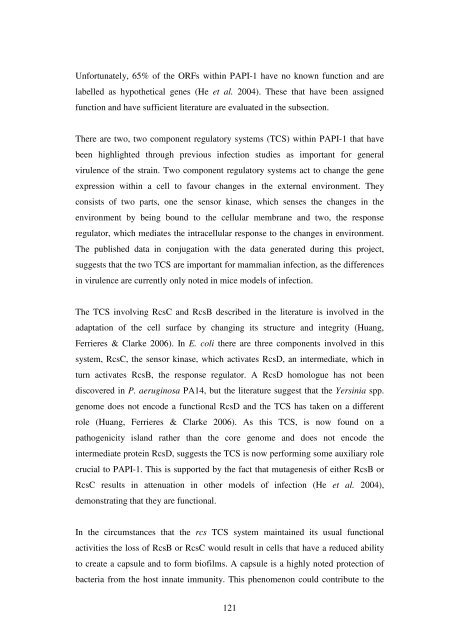5 The role of quorum-sensing in the virulence of Pseudomonas ...
5 The role of quorum-sensing in the virulence of Pseudomonas ...
5 The role of quorum-sensing in the virulence of Pseudomonas ...
Create successful ePaper yourself
Turn your PDF publications into a flip-book with our unique Google optimized e-Paper software.
Unfortunately, 65% <strong>of</strong> <strong>the</strong> ORFs with<strong>in</strong> PAPI-1 have no known function and are<br />
labelled as hypo<strong>the</strong>tical genes (He et al. 2004). <strong>The</strong>se that have been assigned<br />
function and have sufficient literature are evaluated <strong>in</strong> <strong>the</strong> subsection.<br />
<strong>The</strong>re are two, two component regulatory systems (TCS) with<strong>in</strong> PAPI-1 that have<br />
been highlighted through previous <strong>in</strong>fection studies as important for general<br />
<strong>virulence</strong> <strong>of</strong> <strong>the</strong> stra<strong>in</strong>. Two component regulatory systems act to change <strong>the</strong> gene<br />
expression with<strong>in</strong> a cell to favour changes <strong>in</strong> <strong>the</strong> external environment. <strong>The</strong>y<br />
consists <strong>of</strong> two parts, one <strong>the</strong> sensor k<strong>in</strong>ase, which senses <strong>the</strong> changes <strong>in</strong> <strong>the</strong><br />
environment by be<strong>in</strong>g bound to <strong>the</strong> cellular membrane and two, <strong>the</strong> response<br />
regulator, which mediates <strong>the</strong> <strong>in</strong>tracellular response to <strong>the</strong> changes <strong>in</strong> environment.<br />
<strong>The</strong> published data <strong>in</strong> conjugation with <strong>the</strong> data generated dur<strong>in</strong>g this project,<br />
suggests that <strong>the</strong> two TCS are important for mammalian <strong>in</strong>fection, as <strong>the</strong> differences<br />
<strong>in</strong> <strong>virulence</strong> are currently only noted <strong>in</strong> mice models <strong>of</strong> <strong>in</strong>fection.<br />
<strong>The</strong> TCS <strong>in</strong>volv<strong>in</strong>g RcsC and RcsB described <strong>in</strong> <strong>the</strong> literature is <strong>in</strong>volved <strong>in</strong> <strong>the</strong><br />
adaptation <strong>of</strong> <strong>the</strong> cell surface by chang<strong>in</strong>g its structure and <strong>in</strong>tegrity (Huang,<br />
Ferrieres & Clarke 2006). In E. coli <strong>the</strong>re are three components <strong>in</strong>volved <strong>in</strong> this<br />
system, RcsC, <strong>the</strong> sensor k<strong>in</strong>ase, which activates RcsD, an <strong>in</strong>termediate, which <strong>in</strong><br />
turn activates RcsB, <strong>the</strong> response regulator. A RcsD homologue has not been<br />
discovered <strong>in</strong> P. aerug<strong>in</strong>osa PA14, but <strong>the</strong> literature suggest that <strong>the</strong> Yers<strong>in</strong>ia spp.<br />
genome does not encode a functional RcsD and <strong>the</strong> TCS has taken on a different<br />
<strong>role</strong> (Huang, Ferrieres & Clarke 2006). As this TCS, is now found on a<br />
pathogenicity island ra<strong>the</strong>r than <strong>the</strong> core genome and does not encode <strong>the</strong><br />
<strong>in</strong>termediate prote<strong>in</strong> RcsD, suggests <strong>the</strong> TCS is now perform<strong>in</strong>g some auxiliary <strong>role</strong><br />
crucial to PAPI-1. This is supported by <strong>the</strong> fact that mutagenesis <strong>of</strong> ei<strong>the</strong>r RcsB or<br />
RcsC results <strong>in</strong> attenuation <strong>in</strong> o<strong>the</strong>r models <strong>of</strong> <strong>in</strong>fection (He et al. 2004),<br />
demonstrat<strong>in</strong>g that <strong>the</strong>y are functional.<br />
In <strong>the</strong> circumstances that <strong>the</strong> rcs TCS system ma<strong>in</strong>ta<strong>in</strong>ed its usual functional<br />
activities <strong>the</strong> loss <strong>of</strong> RcsB or RcsC would result <strong>in</strong> cells that have a reduced ability<br />
to create a capsule and to form bi<strong>of</strong>ilms. A capsule is a highly noted protection <strong>of</strong><br />
bacteria from <strong>the</strong> host <strong>in</strong>nate immunity. This phenomenon could contribute to <strong>the</strong><br />
121














